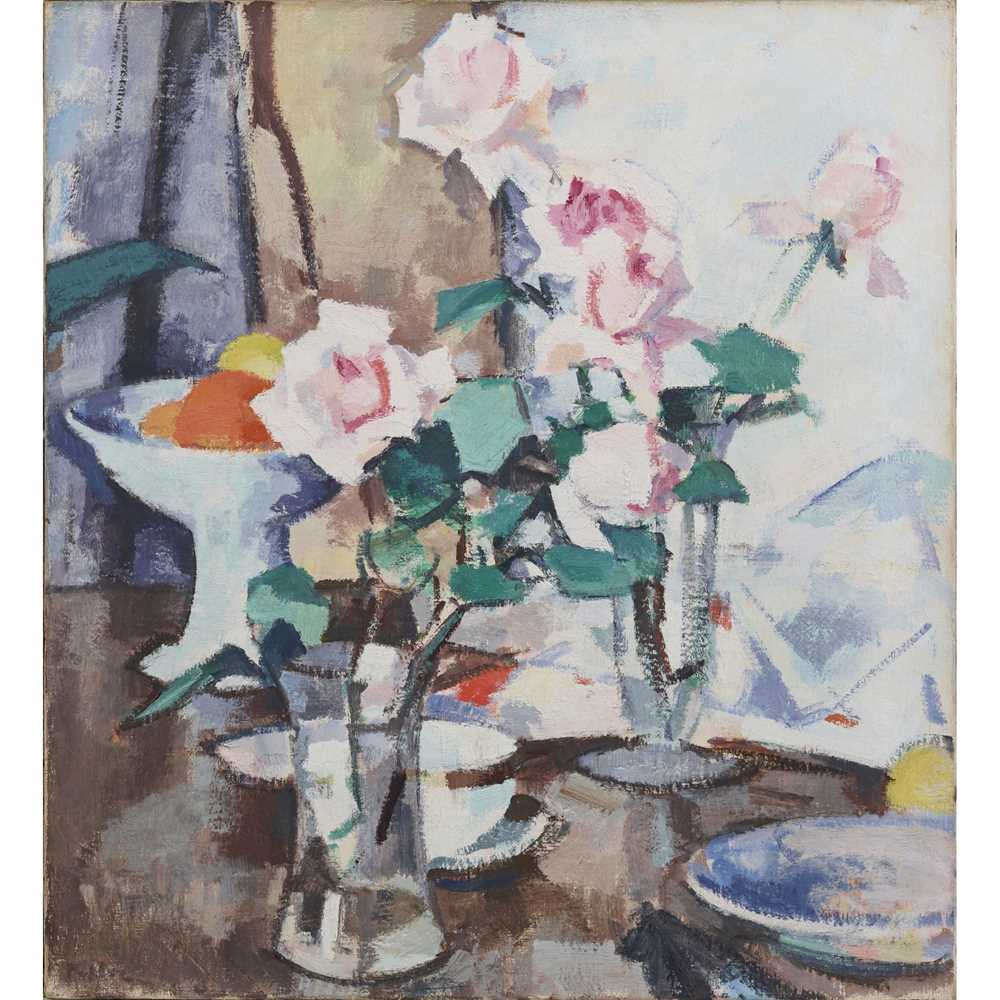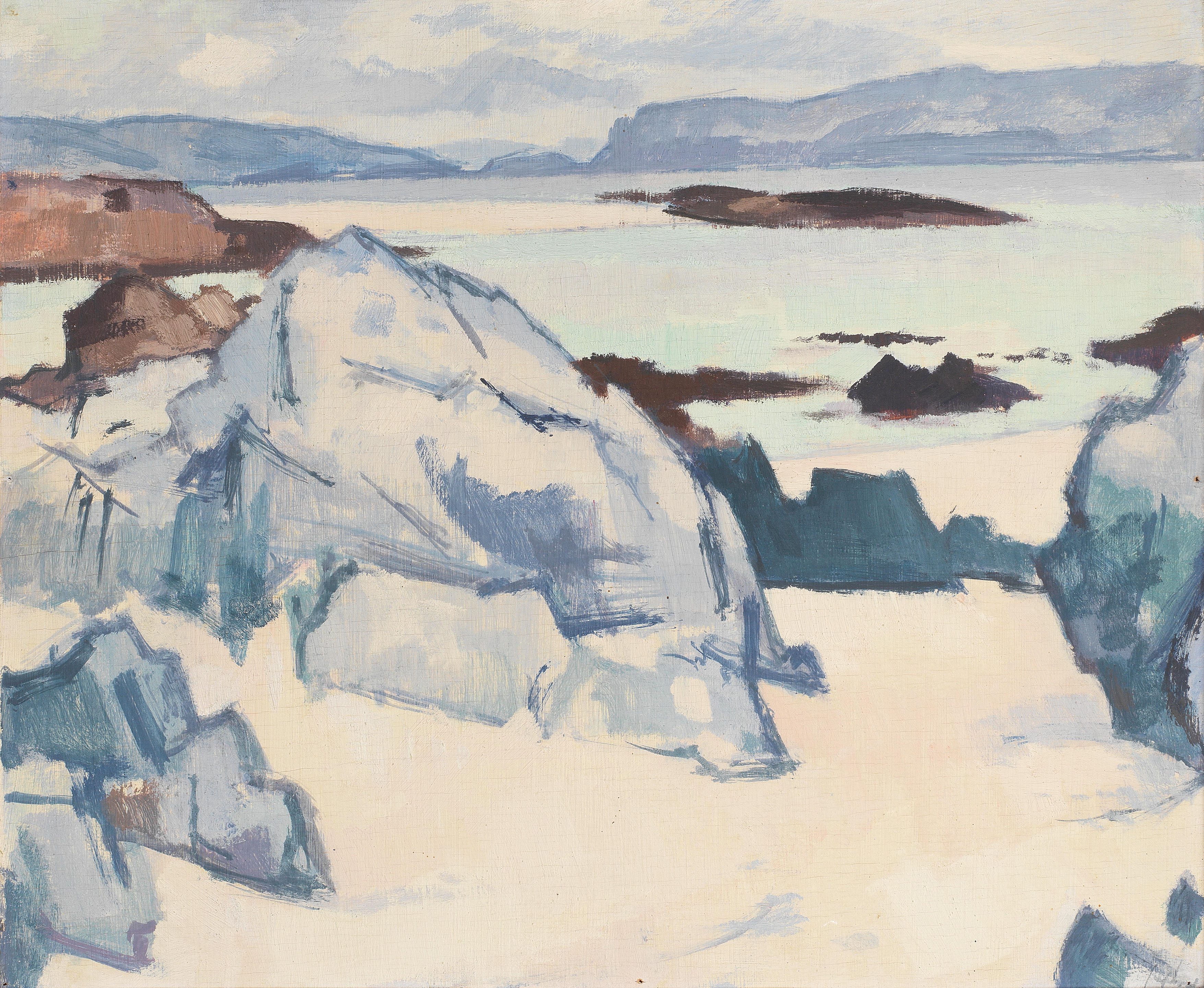, as ‘Still Life with Pears (The White Jug)’ Portland Gallery, London Exhibited: London, Portland Gallery, The Scottish Colourists, 14 June-19 July 2002, no.52 London, Portland Gallery in association with The Scottish Gallery, Edinburgh, S. J. Peploe (1871-1935), 7-29 November 2012, no.18, Ill.col.p.29. Still Life with Jug and Pears of c.1925 reveals Peploe’s mastery of the still life genre, which came to maturity in his practice during the 1920s. He summed up his dedication to the theme, even beyond the landscapes and portraits for which he is also celebrated, in 1929, when he declared: ‘there is so much in mere objects, flowers, leaves, jugs, what not – colours, forms, relation – I can never see mystery coming to an end.’[i] The still life was the primary focus of the work made in his longest-serving studio, at 54 Shandwick Place in Edinburgh’s West End. Peploe moved there in 1917 after it was vacated by his friend, the artist James Paterson and maintained it until a move to nearby Castle Street in 1934. The Director of the National Galleries of Scotland, Stanley Cursiter described it thus: ‘the room had a large, high and well-placed window. The scheme of decoration was…kept in a very light key and he surrounded himself with brilliant colours.’[ii] As Roger Billcliffe has explained: ‘Peploe set himself as a target the perfect still-life painting. It had been his first love and his first serious achievements had been in still-life. His temperament made him ideally suited to the task. His calm reasoning and thoughtful manner enabled him to make a careful analysis of the problems which face the still-life painter and he set about resolving them.’[iii] A sense of this dedication is clear in a description of visiting Peploe in his studio by his niece, Margery Porter: ‘How well I recollect my Mother and myself climbing those steep stairs and arriving panting at the top to ring his bell in fear and trembling lest our climb had been in vain. But usually he would usher us in wearing a white painting coat and a crownless hat…The studio was a large one, round which I would prowl entranced, after strict warnings not to disturb the still-life group which would almost inevitably be covering the table. My uncle would arrange and re-arrange these groups for perhaps three days before he was satisfied that the balance and construction were perfect, then he would paint them quite rapidly.’[iv] Alongside a cast of cherished objects, including jugs, plates, bowls and various lengths of fabric, Peploe would introduce flowers or fruit to his still lifes according to the season. The apples and pears of Still Life with Jug and Pears would suggest that it is an autumnal painting. This caused some consternation amongst the purveyors of such produce, as explained by Cursiter: ‘When he selected his flowers or fruit from a painter’s point of view he presented a new problem to the Edinburgh florists. They did not always understand when he rejected a lemon for its form or a pear for its colour and he remained unmoved by their protestations of ripeness or flavour.’[v] Still Life with Jug and Pears contains all the hallmarks of Peploe’s work of the mid-1920s as he developed from the highly-complex and high-pitched still lifes of earlier in the decade and progressed towards the more raw and expressive style of the early 1930s. There is an overall feeling of dignity in the arrangement, subtle palette and natural lighting of this painting. The depiction of the pears in the foreground is a masterclass in perspective, whilst the warm tones of the apple to the right provide the colour focal point of the composition. Peploe’s enduring interest in the work of Paul Cézanne is clear, for example in the strength of form created by defined planes of colour, particularly in the fruit. Deliberately distinct brushstrokes convey shadow and reflection. The arrangement of objects is asymmetrical yet perfectly balanced, presided over by the jug. The edge of the table on which
, as ‘Still Life with Pears (The White Jug)’ Portland Gallery, London Exhibited: London, Portland Gallery, The Scottish Colourists, 14 June-19 July 2002, no.52 London, Portland Gallery in association with The Scottish Gallery, Edinburgh, S. J. Peploe (1871-1935), 7-29 November 2012, no.18, Ill.col.p.29. Still Life with Jug and Pears of c.1925 reveals Peploe’s mastery of the still life genre, which came to maturity in his practice during the 1920s. He summed up his dedication to the theme, even beyond the landscapes and portraits for which he is also celebrated, in 1929, when he declared: ‘there is so much in mere objects, flowers, leaves, jugs, what not – colours, forms, relation – I can never see mystery coming to an end.’[i] The still life was the primary focus of the work made in his longest-serving studio, at 54 Shandwick Place in Edinburgh’s West End. Peploe moved there in 1917 after it was vacated by his friend, the artist James Paterson and maintained it until a move to nearby Castle Street in 1934. The Director of the National Galleries of Scotland, Stanley Cursiter described it thus: ‘the room had a large, high and well-placed window. The scheme of decoration was…kept in a very light key and he surrounded himself with brilliant colours.’[ii] As Roger Billcliffe has explained: ‘Peploe set himself as a target the perfect still-life painting. It had been his first love and his first serious achievements had been in still-life. His temperament made him ideally suited to the task. His calm reasoning and thoughtful manner enabled him to make a careful analysis of the problems which face the still-life painter and he set about resolving them.’[iii] A sense of this dedication is clear in a description of visiting Peploe in his studio by his niece, Margery Porter: ‘How well I recollect my Mother and myself climbing those steep stairs and arriving panting at the top to ring his bell in fear and trembling lest our climb had been in vain. But usually he would usher us in wearing a white painting coat and a crownless hat…The studio was a large one, round which I would prowl entranced, after strict warnings not to disturb the still-life group which would almost inevitably be covering the table. My uncle would arrange and re-arrange these groups for perhaps three days before he was satisfied that the balance and construction were perfect, then he would paint them quite rapidly.’[iv] Alongside a cast of cherished objects, including jugs, plates, bowls and various lengths of fabric, Peploe would introduce flowers or fruit to his still lifes according to the season. The apples and pears of Still Life with Jug and Pears would suggest that it is an autumnal painting. This caused some consternation amongst the purveyors of such produce, as explained by Cursiter: ‘When he selected his flowers or fruit from a painter’s point of view he presented a new problem to the Edinburgh florists. They did not always understand when he rejected a lemon for its form or a pear for its colour and he remained unmoved by their protestations of ripeness or flavour.’[v] Still Life with Jug and Pears contains all the hallmarks of Peploe’s work of the mid-1920s as he developed from the highly-complex and high-pitched still lifes of earlier in the decade and progressed towards the more raw and expressive style of the early 1930s. There is an overall feeling of dignity in the arrangement, subtle palette and natural lighting of this painting. The depiction of the pears in the foreground is a masterclass in perspective, whilst the warm tones of the apple to the right provide the colour focal point of the composition. Peploe’s enduring interest in the work of Paul Cézanne is clear, for example in the strength of form created by defined planes of colour, particularly in the fruit. Deliberately distinct brushstrokes convey shadow and reflection. The arrangement of objects is asymmetrical yet perfectly balanced, presided over by the jug. The edge of the table on which



.jpg)









Testen Sie LotSearch und seine Premium-Features 7 Tage - ohne Kosten!
Lassen Sie sich automatisch über neue Objekte in kommenden Auktionen benachrichtigen.
Suchauftrag anlegen